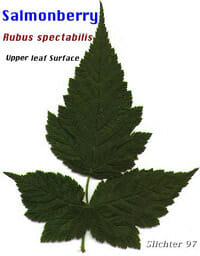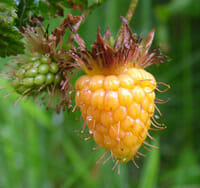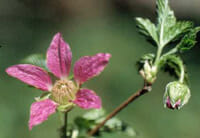Salmonberry – Rosales Rosaceae Rubus chamaemorus
 |
 |
 |
Identification & Description:
Salmonberry is a deciduous upright shrub 6 to 12 feet (2 to 4 m) tall. It is usually found with one or more other deciduous shrub species, such as red elderberry, thimbleberry, twinberry, or cascara). Salmonberry typically grows beneath a canopy of red alder.
Salmonberry flowers in February and March and produces edible, mature fruit in June and July. Small unripe fruit has a salmon color. The fruit grows sweeter as it ripens, and the color shifts toward red.
Salmonberry is a deciduous shrub from 1-4 meter in height. It has erect or arching stems. Stems which grow in the open tend to be unbranched, while those in shade are more likely to be branched. The stems may be smooth (old growth) or densely prickly (new growth). The winter twigs are a distinctive golden-brown to rust-red color.
Salmonberry is strongly rhizomatous, so one needs to watch its growth carefully if using it in a moist woodland garden so that it doesn’t encroach upon other prized plants!
The leaves alternate along the stems. They are ternately compound, usually with 3 triangular leaflets, although 5 may occasionally be found. The tips of the leaflets are often sharply pointed. The terminal leaf is largest, ranging from 4-9 cm in length. All the leaflets may be unequally lobed, and all have doubly-toothed margins.
1-2 flowers are found on short, leafy side branches. The 5 lobes of the calyx are spreading, ovate-lanceolate in shape and from 9-15 mm in length. The 5 petals are red to reddish-purple. They are showy, twice as long as the sepals, and obovate-elliptic in shape. There are 75-100 stamens and numerous pistils. The fruit is raspberry-like with a reddish to salmon coloration.
Habitat:
Salmonberry may be found in moist lowland forests and in wetlands or along streams. It may be found as individual plants or as part of dense thickets.
Range:
Salmonberry may be found from Alaska south to northwestern California. It is most common between the Pacific coast and the Cascade crest. It rarely seen east of the Cascades.
In the Columbia River Gorge, it may be found between the elevations of 100′-4500′ from the western end of the gorge to as far east as Dog, Mt..